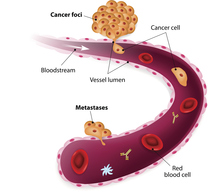Platform for Detection of Metastatic Potential
TECHNOLOGY NUMBER: 7329

OVERVIEW
A biomaterial scaffold to detect and collect metastatic cancer cells early in the disease- A means to recreate cellular and immune responses common in metastatic sites
- Permits detection of metastatic spread earlier than would existing radiologic techniques
BACKGROUND
The spread of primary cancer to metastatic sights in the body results from a complex set of events and leads to a diminished prognosis. Tumor cells may readily shed into the lymphatic system or blood stream, though the formation of a metastatic site of disease is not random but is influenced by the properties of the local environment. Specifically, colonization of an anatomic site by these stray cells commonly requires communication and collaboration with fibroblasts, immune cells, and endothelial cells. Additionally, soluble factors and extracellular matrix play a role in establishing a microenvironment conducive to tumor cell homing and colonization.
The formation of these developing sites of disease may occur well before the metastatic burden of disease reaches sufficient size and activity to be detected by existing radiographic studies. One of the limitations in accurate staging and effective treatment for cancer is the lack of robust technologies available to detect early metastatic events. Existing methods for detecting circulating tumor cells (CTC) are limited by high biomarker sensitivity and the need for specificity in the face of a low number of CTCs. Furthermore, recovered CTCs may not accurately represent the population of cells capable of achieving the complex set of requirements to form a metastatic site. A need exists for novel technologies to aid in the detection of metastatic events in the nascent setting.
INNOVATION
Researchers have developed a biomaterial scaffold that may be placed in a patient to both detect and collect metastatic cancer cells at a time point early in the disease process. The invention employs a bioresorbable implant comprised of a polymer scaffold and one or more chemical or biological agents that recruit circulating cancer cells which can become metastases. The environment created by the implant then serves as a system by which to investigate the dynamic immune response and cellular events associated with formation of metastatic sites. The polycaprolactone (PCL) scaffold implant serves as a pre-metastatic niche which can be integrated into disease management plans by potentially serving as a sentinel site for detection of metastatic or recurrent disease. Scaffolds could be placed and then recovered after a specified time frame to allow examination of the metastatic tumors and enable development of patient-specific treatment regimens. The researchers utilized PCL scaffolds in metastatic breast cancer murine models to confirm that metastatic cells can be recruited to the scaffold, and those cells can be detected prior to cancer cell colonization of other major organs.